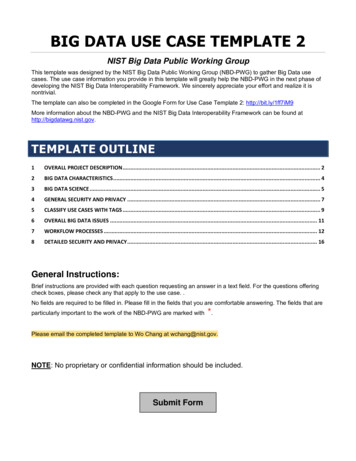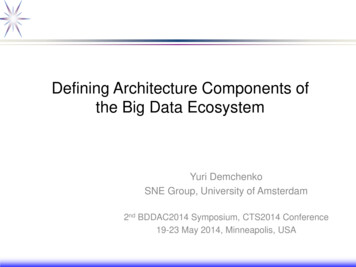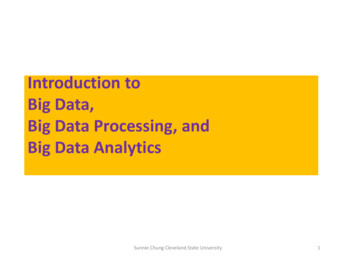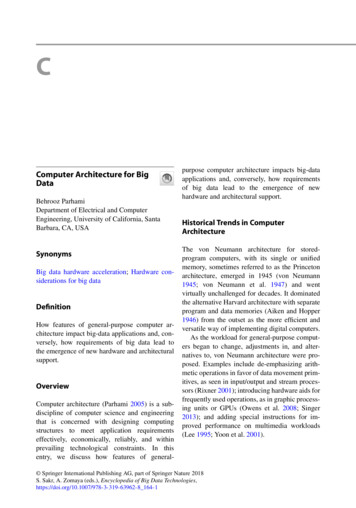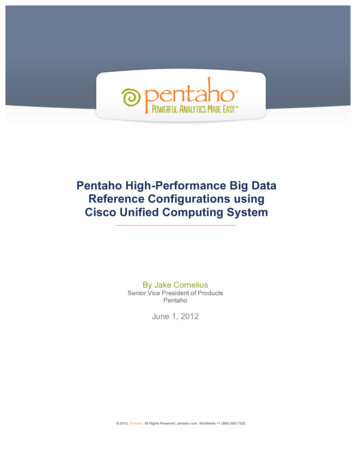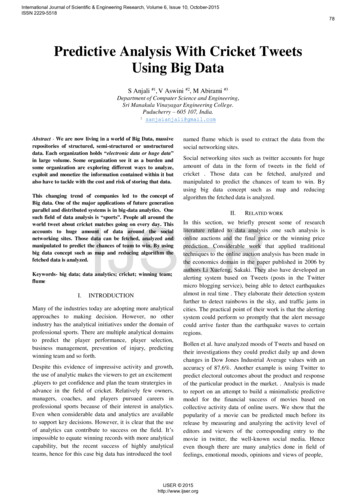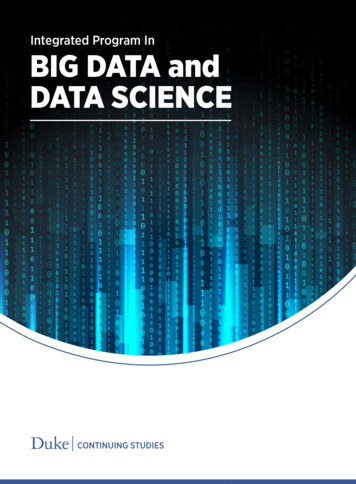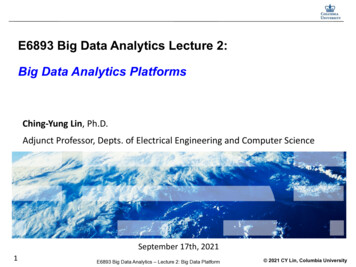
Transcription
Higher Education Studies; Vol. 10, No. 4; 2020ISSN 1925-4741E-ISSN 1925-475XPublished by Canadian Center of Science and EducationDesign on Big data Platform-based in Higher Education InstituteSajeewan Pratsri1 & Prachyanun Nilsook21Thepsatri Rajabhat University, Lopburi, Thailand2King Mongkut’s University of Technology North Bangkok, ThailandCorrespondence: Sajeewan Pratsri, Thepsatri Rajabhat University, Lopburi, Thailand. E-mail:sajeewan.p@lawasri.tru.ac.thReceived: August 15, 2020doi:10.5539/hes.v10n4p36Accepted: September 30, 2020Online Published: October 8, 2020URL: ing to a continuously increasing amount of information in all aspects whether the sources are retrievedfrom an internal or external organization, a platform should be provided for the automation of whole processes inthe collection, storage, and processing of Big Data. The tool for creating Big Data is a Big Data challenge.Furthermore, the security and privacy of Big Data and Big Data analysis in organizations, government agencies,and educational institutions also have an impact on the aspect of designing a Big Data platform for highereducation institute (HEi). It is a digital learning platform that is an online instruction and the use of digital mediafor educational reform including a module provides information on functions of various modules betweencomputers and humans. 1) Big Data architecture is a framework for an architecture of numerous data whichconsisting of Big Data Infrastructure (BDI), Data Storage (Cloud-based), processing of a computer system thatuses all parts of computer resources for optimal efficiency (High-Performance Computing: HPC), a networksystem to detect the target device network. Thereafter, according to Hadoop’s tools and techniques, when BigData was introduced with Hadoop's tools and techniques, the benefits of the Big Data platform would providedesired data analysis by retrieving existing information, to illustrate, student information and teachinginformation that is large amounts of information to adopt for accurate forecasting.Keywords: big data, platform-based, educational institute, higher education institute1. IntroductionAs in the current situation, Covid-19 pandemic affects all educational societies as well. To proceed the education,educational institutions must adapt to the situation instantly. This current situation has resulted in anunprecedented drive for online learning that many people, including the digital learning platform providers, offersupport for the education, namely, to formulate additional social problems for education to resolve. Hence, this isa critical moment to reflect on how alternative education institutions today are impacted in this circumstance ofCovid-19 and in term of online learning. Whether they complement the capitalist’s view as an educational tool orpromote human growth or not.Use of information, the capacity of information, and content generated by an individual organization, thedevelopment of communication technology such as internet technology and information technology for examplevarious types of electronic services while the Big Data industry evolved from these phenomena. (Beyadar et al.,2017) Stated information is so extensive that operations such as collection, storage, and analysis cannot beperformed by conventional software and data management tools. A comprehensive problem in higher educationinstitutions around the world is academic success and student retention. As higher education institutions collectcumulative students’ data moreover, as the database of a student record becomes more complex and accessiblethus, we are entering a new era of information that used to improve student success, improve processes, and useresources more efficiently, better data analysis and student selection processes, more accurate enrollmentpredictions, and an early warning system that identifies and helps students at risk from studying.The framework and architecture of data analysis have been used and applied in many information systemsresearch studies (IS). The causal mechanism remains unspecified through the use of scientific research methods.The study design combines various analytical frameworks to develop more comprehensive Big Data architecturefor analytical learning. The survey was conducted to review similar and different opinions from different peoplewith different views and interests. This practice is to coordinate the accuracy and reliability of the research36
http://hes.ccsenet.orgHigher Education StudiesVol. 10, No. 4; 2020results.In this Research, we will describe the nature and architecture of Big Data on higher education which presentedthe tools and techniques of Hadoop that will be useful to organize and analyze the data that need to apply theeffective tools for Big Data processing.2. Big Data2.1 Definition of Big DataBig Data is the enormous amount of data that exists in a single type of organization whether the source is froman internal or external organization. Songsangyos & Nilsook, (2015) said that the processing of a commondatabase system to support the enormous amount of data, data rates increase rapidly and is in the form ofstructure or semi-structure which cannot store data in the database. This is in accordance with (Cravero, 2018)found that a new generation of technology and architecture which designed to extract the value of the giganticvolume of data from a wide variety of sources by enabling high-speed discovery or analysis. Murumba &Micheni, (2017) also mentioned that Big Data in higher education has technological innovation and developmentof the data storage analysis and cloud computing, combined with the growing ownership of digital devices,education users can collect, manage, and maintain massive amounts of data for the benefit of driving futureinstitutional strategies and policy determination to be available in a complex platform (Moreno et al., 2019)Moreover, there is a wide range of technologies related to privacy and security (Altaye & Nixon, 2019) Insummary, Big Data is a large amount of data that is collected and managed as databases, such as business, socialmedia, events, photos, videos, sensors, emails, text files, and applications which all are kept as a huge source ofBig Data that can be explained by a variety of speeds, volumes, and nature. To extract useful information fromBig Data, excellent processing with analytical capability is necessary. Big Data is divided into structured,unstructured, and semi-structured data such as content, photos, and comments.2.2 Characteristics of Big Data(Daniel, 2014; Songsangyos & Nilsook, 2015) stated that the 5V characteristics of Big Data consist of Volumecharacteristic which is the amount of data should be sufficient when it is analyzed, it will gain insights thatcorrespond to reality, for example, we have information about the age and gender of most customers thatenabling us t accurately find information of the general demographic of customers. On the other hand, if we haveonly a small portion of customer information, the result value may not be accurate. Velocity characteristic, theinformation is generated rapidly, continuously, and modernly, it allows us to analyze results for decision makingand respond promptly, furthermore, we will be able to manage Big Data in order to successfully manageKnowledge Management (KM). Variety characteristics, the variety of information, and types of information.Both structured and unstructured data are table data stored in the database in which structured data consists ofnumeric data, letter data, date, etc. and unstructured data includes information, images, audio, video, andcomments via social media.(Kumar & Singh, 2019; Hariri et al., 2019; Altaye & Nixon, 2019; Rizk et al., 2019; Al-Barashdi & Al-Karousi,2019) presented that Big Data requires high velocity and variety so the Veracity of data should have thereliability of the data source and the accuracy of the dataset with a process for checking and confirming theaccuracy of the information which is directly related to the results of data analysis. To maintain accurate datawithout any duplication of the dataset is certainly the hardest and the most time-consuming. Thus, it isconsidered as the most important feature in generating Big Data. Value characteristic is the valuable data that canbe useful or important to business use such as data analysis for summary and data analysis for business planningto create product value or increase the competitiveness in the market of the target product. Summarized as shownin Figure 1.37
http://hes.ccsenet.orgHigher Education StudiesVol. 10, No. 4; 2020Figure 1. Characteristics of Big Data2.3 Big Data Architecture FrameworkTo emphasize about Big Data architecture framework, (Songsangyos & Nilsook, 2015) suggested that thecomponents of Big Data Architecture, consisting of first, data model structure and type which is the relationship /non-related data model and the file system. Later, the management of Big Data is to conduct a Big Data lifecycle,Big Data transition, or Big Data state, sources, and storage. Afterward, Big Data analysis and tool is a method ofapplication and consideration by using Big Data The objective of presentation and visualization is to achieve BigData Infrastructure (BDI) and data storage (Cloud-based), processing of a computer system that uses all parts ofcomputer resources for optimal efficiency (High-Performance Computing: HPC), a network system to detect thetarget device network or Big Data transferred operation, and support operation. More importantly, Big Datashould be secure and private namely data security and privacy while stopping mobile and reliable processingenvironments. Summarized as shown in Figure 2.Figure 2. Big Data Architecture Framework2.4 Security and Privacy in Big DataTo describe security and privacy in Big Data, (Jain et al., 2019) said that initially, the security assessment in thedistribution framework which results in the optimal safety practices for unrelated resources. Then, the security ofdata sources and records of changes must be prepared in order to actualize real-time performance check whetherhow the data endpoint is and analyze various privacy information. Besides, the accessibility of informationshould be regulated by determining access rights for secured communication. Finally, data sources andperformance should be reviewed in detail.2.5 Big Data in Higher EducationTo review Big Data in higher education, (Altaye & Nixon, 2019; Murumba & Micheni, 2017) said that first, it isPredictive Analytics, using Data Mining techniques can benefit a predication of student behavior, analysis ofactivities performed by students as they interact with the Learning Management System, predicting studentperformance based on the activities or the measure to be taken to improve student performance. Next, BehaviorDetection is to describe students' faces, expressions after school by participation activities, based on playermovement in games, and modeling knowledge and understanding. He said that this type of modeling helps tounderstand the learning process of users who interact with the system and adapting the learning environment forusers to adopt the results of the behavior examination to predict risks (Risk Prediction). A technique that uses BigData to predict the risks involved in students. Some students abandoned the course, their activity was monitoredand the engagement score was predicted and using historical data to create a student behavior model and a modelused to calculate risk by applying a students’ skill estimation to transform the education system to suit students'38
http://hes.ccsenet.orgHigher Education StudiesVol. 10, No. 4; 2020skills.Skills are calculated based on students’ interaction with the system or on a message board or forums in order tocarry out financial planning, check student performance. Finally, an intelligent teaching system will be formedwith a teaching model and games that can be used to generate opportunities to collect and analyze student datafrom discoverable patterns and trends to support the interaction between humans and information technologyenvironment. From the above, it can be summarized as in Figure 3.Figure 3. Big Data in Higher Education3. Hadoop’s Tools and Techniques for Big DataHadoop is open-source software that is built as a data storage platform. It provides a framework for storing andprocessing enormous data called Big Data. Hadoop is scalable and able to handle large amounts of data. (Kumar& Singh, 2019) showed that the Hadoop platform was developed to record, organize, and analyze data, effectivetools are needed to separate meaningful output from Big Data. Various tools used in the processing of Big Dataare detailed in Table 1.39
http://hes.ccsenet.orgHigher Education StudiesVol. 10, No. 4; 2020Table 1. Hadoop’s Tools and TechniquesHadoop’s Tools and Techniques (Rizk et al., 2019; Kumar & Singh, 2019; Cravero, 2018; Cravero et al.,2018)Apache HiveData storage’s built on Hadoop to simplify a Big Data framework to make it easier toaccess the information you need. Due to Hadoop's search capability is limited and thecomplexity of the MapReduce framework, developers must write a complex programthat may be difficult to maintain and use even apply it for simple analysis. (Rizk et al.,2019)Apache HadoopAn open-source software project for building a highly stable and extendable distributedcomputing system.HadoopThe primary storage system used in the Hadoop HDFS software creates a data blockDistributed Filemodel in a cluster for reliability and fast calculation.System (HDFS)MapReduceProgramming framework helps processing data with multiple datasets runningsimultaneously which will have to rely on multiple computers to cooperate.Apache PigTool likes Hive that allows data processing without Map / Reduce Pig programming,using a simple scripting program called Pig Latin instead of Pig which is suitable forETL for data conversion in various formats.Apache HBaseA tool that allows Hadoop to read and write data in Real-Time Random Access. It willbe a large table that can store unlimited data in rows or columns. HBase is compared tomaking Hadoop be a NoSQL database.Apache OozieA workflow tool that will allow us to integrate Hadoop system processing instructionssuch as Map / Reduce, Hive, or Pig into a workflow.Apache AvroA framework for permanent data serialization and remote procedure calls betweenHadoop nodes and between client programs and Hadoop services.ApacheA centralized system used by applications to maintain systems including organizingZookeeperother elements between nodes.Apache YarnThe YARN distributed application has two components; the Resource Manager (RM)that manages all the resources within the cluster needed for the work, and the NodeManager (NM) that resides on every host in the cluster and manages the availableresources independently.Apache SqoopTool for transferring data between tables in an RDBMS database format such as SQLServer, Oracle, or MySQL and HDFS data by Hadoop.Apache FlumeTool for retrieving data from other systems in real-time into HDFS, such as retrievinglogs from a web server. To retrieve these data, the Agent must be installed on the server.4. Benefits of Big DataDue to the adoption of Big Data, (Murumba & Micheni, 2017; Songsangyos & Nilsook, 2015) mentioned thatBig Data is helpful on-demand data analysis by retrieving existing data such as student data, teaching data. Thishuge amount of data is adopted for an accurate prediction. Big Data adaptation can create products or improveservices to meet customer or users’ satisfaction, such as delivering to customers when purchased through thenetwork, moreover, it is a collection of different data sources and types since the data comes from a variety ofsources.5. Platform-Based in Higher EducationThe platform used in higher education includes; 1) Social Learning Platforms that use sophisticated and costlydata analytics and (Xi 2018) said that it is a traditional analytic tool to provide useful insights while continuing topressure educational establishments to deal with the generated information. 2) E-learning Platform is applied tofacilitate data processing in parallel, which (Dahdouh et al., 2019) purposed that to help to process data in costcalculation by using Spark-based and Hadoop in decentralized computing and data analytics. For validation, thesystem can handle large amounts of data and scalable compute capability. 3) Digital Learning Platform, theweb-based teaching and learning platform, offers a wide range of functions teaching and training design fororganizations, and on-site learning space. Additionally, they can provide works, various educational materials,and media for solving learning problems. Furthermore, there is an opportunity to exchange and learn together toparticipate. (Hartmann et al., 2019; Sousa & Rocha, 2018) added that it is an approach to online learning and40
http://hes.ccsenet.orgHigher Education StudiesVol. 10, No. 4; 2020using digital media for educational reform which consists of flexibility, individuality, quality, learning analytics,cost-effectiveness, and flipped learning.6. Big Data Platform-Based in Higher EducationAccording to the concept of Big Data and analysis, this can be applied to a variety of higher education in themanagement and instruction plus improve services to meet the needs of teachers or learners including seekingand processing donor financial planning, and student performance checking and monitoring as shown in Figure4.Figure 4. Big Data Platform-Based in Higher EducationAccording to Figure 4, it shows an overview of the big data platform design in higher education which is adigital learning platform adopted an online learning management and digital media adaptation for a businessclass educational reform and an information class display module providing information about the functions ofthe modules between computer and human. The big data architecture is a framework for a large data architectureconsisting of; 1) Characteristics of Big Data, 2) Hadoop Tools and Techniques, 3) Higher Education Platforms,and 4) Big Data Architecture Framework.Characteristics of Big Data (Daniel, 2014; Songsangyos & Nilsook, 2015; Kumar & Singh, 2019; Hariri et al.,2019; Altaye & Nixon, 2019; Rizk et al., 2019; Al-Barashdi & Al-Karousi, 2019) states that the 5Vcharacteristics of big data consists of Volume which is a quantity of accurate data for an analysis, Velocity is theability of consequence analysis for making a decision and responding promptly to a variety of circumstances.Variety is diversified structured and unstructured data in the form of either RDBMS, text, XML, JSON or Image,Veracity is data with multiple quality and value levels for an analysis, and Value is worthwhile data adoptionwhen receive an accurate data leads to development that can measure success concretely.Hadoop is an open source software created as a data storage platform which provides a framework for storingand processing enormous data namely Big Data. Hadoop is scalable and flexible to support the enormous amountof data due to Hadoop contains a data processing distributed across computers with clustered format leading tounlimited and reliable data management capability. (Kumar & Singh, 2019) said that the Hadoop platform wasdeveloped to record, organize, and analyze data whereupon an effective tool is necessary to distinguishmeaningful output from big data which includes Apache Hive, Apache Hadoop, Hadoop Distributed File System(HDFS), MapReduce, Apache Pig, Apache HBase, Apache Oozie, Apache Avro, Apache Zookeeper, ApacheYarn, Apache Sqoop and Apache Flume. Hadoop is not suitable for small and real-time data as Hadoop is a batchprocessing and structured data storage furthermore, another alternative is much more interesting such as SQL.Hadoop is eligible for universities and companies where utilize Hadoop for web-based data collection since thecurrent data analysis requires external data as consideration variables moreover, the external data is unstructuredand has a high-velocity expansion rate, Hadoop is a favorable selection.Big data in higher education (Altaye & Nixon, 2019; Murumba & Micheni, 2017) is a predictive analysis whichassists divide students into groups for actualizing reports or grouping them by categorizing according to thestudents’ characteristics with similar behavior, learning styles or preferences in the same group to enhance the41
http://hes.ccsenet.orgHigher Education StudiesVol. 10, No. 4; 2020highest learning efficiency. Likewise, Behavior Detection is behavior while studying, such as data sourceretrieved for work, and the successful percentage of work submitting which expedites to understand the learningprocess of the user interacting with the system and improving the learning environment for the user causing theresults of the behavior detection for risk prediction. Big data technique to predict the risk involved with somestudents abandoned their course were monitored and the engagement score was predicted. Historical data wasapplied to create student behavior model and risk measurement model by using student skill estimation to leadthe educational information system can assist in arranging a course that is suitable for individual learners.Especially the college and university learning plans which the information can facilitate students to organize andenroll the course that superbly suits them. Finally, an intelligent teaching system will be conducted to providestudents insights about how their learning is at each level which each student will have a different learning style.The different learning style affects the academic performance of the course. It has teaching model and valuablegames used to create opportunities for analyzing students’ data from the human interaction model.The big data architecture framework (Songsangyos & Nilsook, 2015) addressed that the elements of the big dataarchitecture, including model data and type framework which is a relationship/non-related data model and a filesystem. Big data management is to manage big data cycle, big data transformation, state of big data, source, andstorage. Big data analysis and tool is a method of using and analyzing big data with the goal of presentation andvisualization to receive Big Data Infrastructure (BDI), cloud-based storage, and High-Performance Computing(HPC). Network system detects the target device network or operates big data transfer, supportive operation, andmost importantly, big data security and privacy should be provided to authorize the person who has an accessright, and designate laws and regulations controls on collecting, using, sharing, storing, and transferringinformation infallibly.7. ConclusionsDue to an information technology including various tools and techniques at present that are available for thedevelopment of Big Data in higher education institutions which enable to update information, teaching andlearning process or analyze data processing greatly by applying predictive analytics using Data Mining technique,it can perform advanced and real-time investigations swiftly and cost-effectively. Then, using an intelligentteaching system that can analyze students’ data about the interaction during teaching and learning. However,implementing higher education platforms have many challenges, especially it must hold a low level in term ofinvestment and network management systems to provide a wide range of communication and access toinformation extensively. In this article, we proposed architecture and implementation for the Big Data platform.The concepts that underpinning analysis can be applied to a variety of higher education in term of managementand instruction including improvement of services to meet the needs of teachers or learners also enable to receiveall the services required for efficient adaptation and deployment in educational institutions.ReferencesCravero, A. (2018). Big Data Architectures and the Internet of Things: A Systematic Mapping Study. pp.1219-1226.Al-Barashdi, H., & Al-Karousi, R. (2019). Big Data in academic libraries: literature review and future researchdirections. Journal of Information Studies & Technology, 2018(2), 1-16. https://doi.org/10.5339/jist.2018.13Altaye, A. A., & Nixon, J. S. (2019). A Comparative Study on Big Data Applications in Higher Education.International Journal of Emerging Trends in Engineering Research, 7(12), 2019Beyadar, H., Askari, M., & Askari, A. (2017). A Network platform for creating digital entrepreneurship in cloudenvironment based on big data. In Application of Information and Communication Technologies, AICT 2016- Conference Proceedings. , A., Saldaña, O., Espinosa, R., & Antileo, C. (2018). Big Data Architecture for Water ResourcesManagement: A Systematic Mapping Study. IEEE LATIN AMERICA TRANSACTIONS, 16(3), 902-908.Dahdouh, K., Dakkak, A., Oughdir, L., & Ibriz, A. (2019). Large-scale e-learning recommender system based onSpark and Hadoop. Journal of Big Data, 6(1). https://doi.org/10.1186/s40537-019-0169-4Daniel, B. (2014). Big Data and analytics in higher education: Opportunities and challenges. British Journal ofEducational Technology, 46(5), 904-920. https://doi.org/10.1111/bjet.12230Hariri, R. H., Fredericks, E. M., & Bowers, K. M. (2019). Uncertainty in big data analytics: survey, opportunities,and challenges. Journal of Big Data, 6, 44. https://doi.org/10.1186/s40537-019-0206-342
http://hes.ccsenet.orgHigher Education StudiesVol. 10, No. 4; 2020Hartmann, M., Nestler, A., Wohlrabe, D., Arnold2, F., Hoffmann, J., & Wenkler, E. (2019). Development of adigital learning platform for the planning of manufacturing processes. IOP Conference Series: MaterialsScience and Engineering PAPER. , P., Gyanchandani, M., & Khare, N. (2019). Enhanced Secured Map Reduce layer for Big Data privacy andsecurity. In Journal of Big Data, 6, 30. https://doi.org/10.1186/s40537-019-0193-4Kumar, S., & Singh, M. (2019). Big data analytics for healthcare industry: impact, applications, and tools. BigData Mining and Analytics, 2(1), 48-57. https://doi.org/10.26599/BDMA.2018.9020031Moreno, J., Fernandez, E. B., Serranoand, M. A., & Fernández-Medina, E. (2019). Secure Development of BigData Ecosystems. IEEE Access, 7, 96604-96619. , J., & Micheni, E. (2017). Big Data Analytics in Higher Education: A Review. The InternationalJournal of Engineering and Science, 6(6), 14-21. https://doi.org/10.9790/1813-0606021421Rizk, R., McKeever, S., Petrini, J., & Zeitler, E. (2019). Diftong: a tool for validating big data workflows.Journal of Big Data, 6, 41. os, P., & Nilsook, P. (2015). Big Data in the Cloud for Education Institutions, 32(1).Sousa, M. J., & Rocha, A. (2018). DIGITAL LEARNING IN AN OPEN EDUCATION PLATFORM FORHIGHER EDUCATION STUDENTS. Proceedings of EDULEARN18 Conference, Palma, Mallorca, Spain.pp. 11194-11198. https://doi.org/10.21125/edulearn.2018.2770Xi, Y. (2018). Research on the Construction of Library Data Integration System in Big Data Era. Proceedings ofthe 2018 International Conference on Transportation & Logistics, Information & Communication, SmartCity. sCopyright for this article is retained by the author(s), with first publication rights granted to the journal.This is an open-access article distributed under the terms and conditions of the Creative Commons Attributionlicense (http://creativecommons.org/licenses/by/4.0/).43
To emphasize about Big Data architecture framework, (Songsangyos & Nilsook, 2015) suggested that the components of Big Data Architecture, consisting of first, data model structure and type which is the relationship / non-related data model and the file system. Later, the management of Big Data
